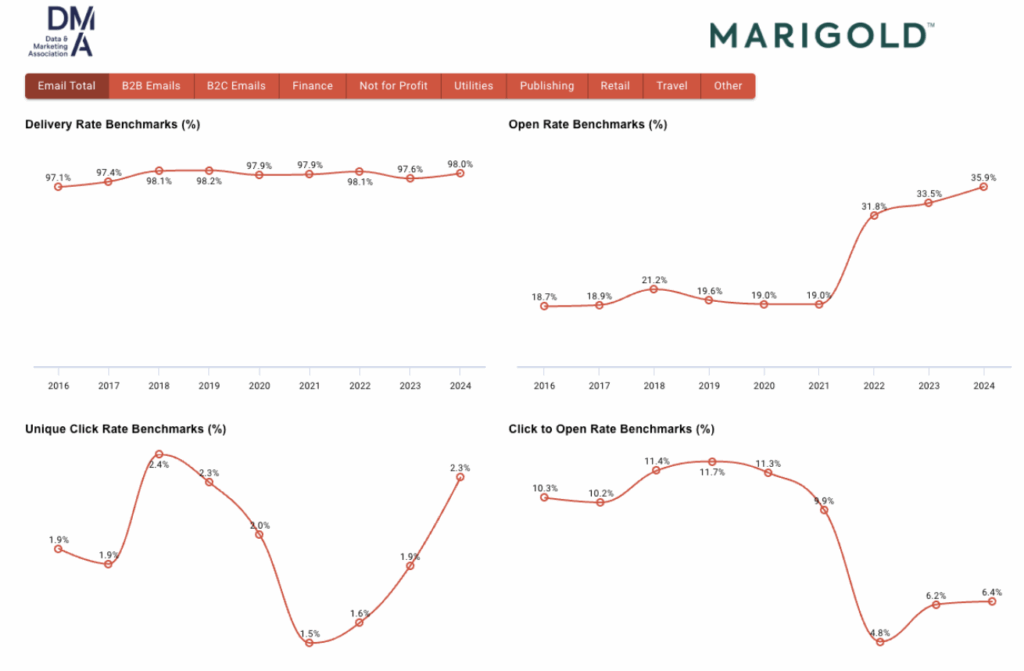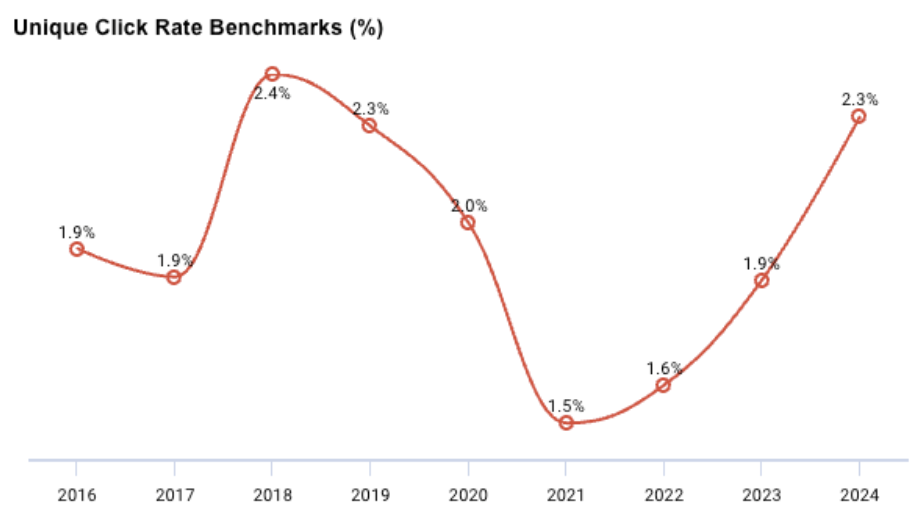The way email delivers value is evolving. It remains the most lucrative channel for driving purchases, but in an age of cross-channel engagement, no single channel operates in a vacuum. Marketers need to treat email as part of the broader brand experience.
Marigold is a returning sponsor of the annual Email Benchmarking Report published by the DMA (Data & Marketing Association).
The DMA’s 2025 interactive report measures more than 400 billion emails sent via seven major Email Service Providers (ESPs). The research aggregates performance across sectors and splits data between B2B and B2C, offering a uniquely comprehensive and interactive view into email marketing effectiveness.
During the DMA’s launch webinar, Ian Gibbs, Insight and Planning Director at the DMA, unpacked this year’s results alongside an experienced panel of speakers:
- Nicola Travis, Head of CRM at Beauty Bay;
- Taha Baba, Digital Marketing Automation Officer at UNHCR;
- Ricky Moxton, CRM Manager at Cotswold Company; and
- Ben Burns, Senior Product Marketing Manager at Marigold.
Here’s what European marketing leaders should consider.
1. The big picture: Four key email metrics improved
For the first time in six years, all four email metrics tracked by the DMA, delivery rate, open rate, click rate, and click-to-open rate, trended upward. Previous years saw declines driven by technical shifts such as Apple Mail Privacy Protection (MPP) and pandemic-related disruption, but the 2024 data tells a story of momentum.

- Delivery rate edged up to 98%, a modest but meaningful shift across 400 billion emails.
- Open rates increased broadly, though reliability challenges persist.
- Clicks rebounded to near pre-pandemic levels.
- CTOs rose as well, defying the typical pattern where higher opens result in lower click rates.
What’s behind this shift in the data? Ian Gibbs, Director of Insight at the DMA, reflects on broader trends:
“This is the effect of what I was talking about earlier: improved loyalty, increased preference for owned channels, and improved performance of direct response advertising. We see that being played out in the email channel.”
Jan Schapmans, Senior Director of Deliverability at Marigold, points to the atypical rise in both opens and clicks as a sign of deeper engagement: “Normally, when open rates go up, especially due to inflated Apple proxy opens, CTO tends to go down. But last year both increased, pointing to more audience-aligned content, better sender reputations, and improved inboxing overall.”
Ben Burns, Senior Product Marketing Manager at Marigold, underscores how industry action contributes to the gains: “Deliverability improvements show people took the [Yahoo and Google] changes seriously. It’s great to see policy changes lead to measurable results.”
2. Relevance starts with data-driven email personalization and testing
Consumers expect messages to reflect their interests and behavior. “There’s a wide understanding that we hold purchase and browsing interest data on them.” said Ricky Moxton, CRM Manager at The Cotsworld Company. “And in return, there’s a greater expectation to use that data to their benefit, by delivering something more personalized and more relevant.”
This expectation is pushing marketers to sharpen their approach through smarter personalization, strategic segmentation, and adaptive content strategies. But delivering relevant messages hinges on data quality, the foundation of effective personalization.
Ian Gibbs, Director of Insight at the DMA, offers a broader perspective on the role of email and its relationship to data:
“Email is not simply a tool for retention, loyalty, upselling and customer service: it is also a channel vital for capturing customer data, maintaining a clean CRM database and providing the hooks with which customer data can be utilized in the paid media space.”
A test-and-learn mindset helps understand and act on what works. Testing not only optimizes performance, it also reveals where your data is strong, where it needs refinement, and how your audience responds. “As a rule of thumb, for us, we never send any communication without a test in place,” said Taha Baba of UNHCR, a Marigold customer. “Whether it’s an A/B, multi-thread, or group test, it is a matter of learning. We’re always learning what resonates and what doesn’t.”
Testing also plays a crucial role when adapting to shifting realities of measurement. While open rates have become less reliable, particularly since Apple Mail Privacy Protection, combining them with click data and post-click behavior still offers useful signals. French retailer Tape à l’Œil, for example, discovered that 60% of their email opens came from Apple Mail, significantly inflating open rate metrics. Through strategic A/B testing on campaign volume and send timing, they redefined engagement around real customer actions.
As Ricky Moxton of The Cotsworld Company noted, “I think on their own, open rates are starting to become a dead metric. I think open rates can only really be measured or benchmarked if they’re combined with something else, which is why we look at clicks to open, showing how engaged a customer is by that click or by that purchase.”
3. Think bigger: Email metrics beyond clicks
Click rates dropped in 2021 but have steadily climbed since. While this rebound is encouraging, panelists cautioned against relying too heavily on clicks as the sole measure of email effectiveness.

“We are very aware that we make an impact just by being a presence in the inbox. We don’t need the open. We don’t need the click. Sometimes we just need to be two sentences on that page, and that’s something that’s a bit intangible and makes segmentation particularly hard,” said Nicola Travers, Head of CRM at Beauty Bay. For Beauty Bay, impact starts with the brand’s presence in the inbox through sender name, subject line, and preview text.
This reflects a broader shift: email is playing an increasingly strategic role in brand-building. Consistent visibility in the inbox strengthens brand recognition beyond any single click. Smart marketers are expanding how they use email: for storytelling, education, and long-term connection.
Travers emphasized the importance of looking at broader customer signals:
“We try and tie it back to the customer behavior.” What is the customer doing? Coming to the website? Buying? Signing up for a waitlist? For us, it’s not the open rate at all, and it’s probably not even the click. We have to look at some of the other signals, which is more difficult, but it’s worth doing.”
4. Earn your place in the inbox
As Ian Gibbs noted, “We saw a distinct and increased preference for being communicated with via owned channels,” a signal that consumers are open to email engagement.
Even if we’re starting out from a general preference for the email channel, don’t forget that this is based on trust. As Ben Burns reminded us, that trust is fragile:
“Email is one of the few channels governed by consent. The inbox is a place of familiarity. It’s a space people choose to let you into, and that means you have to earn your place there every single time. The brands that will win are the ones who take that trust seriously. Start collecting zero-party data. Use preference centers and be respectful, because the moment you take that access for granted, you lose it in a single click.”
This reinforces the idea that email is a privilege, not a guarantee, and that inbox access must be treated with care. It requires more than just compliant practices. It means respecting preferences, honoring unsubscribes, resisting the urge to over-send, and staying relentlessly focused on relevance over volume.
As inboxes become more curated and attention more selective, consent is no longer a one-time opt-in but an ongoing relationship. And it must be re-earned with every email.
5. AI is here in email marketing, but it’s not everything
Artificial intelligence (AI) was a recurring theme in the panel discussion, not as a silver bullet, but as a powerful support tool. From generating subject lines to anticipating how messages are summarized by AI-powered inbox tools, AI is used to enhance performance, streamline testing, and quality-check content.
But across the board, panelists emphasized, it’s still the human that drives success. “AI is a helpful QA step to surface what’s working or not working,” said Ben Burns. “If it can’t understand your message, your customer probably won’t either. It’s still on us to communicate clearly.”
Taha Baba of UNHCR shared how his team is adapting to this reality:
“AI tools are really relying on the first part of the email usually. So what we try to do is put our instructions into the email in a hidden way that helps the tool understand what the email is about. So when it summarizes the email to a donor, it delivers the intended message.”
These examples reflect the growing role of AI in execution but make clear that thinking, testing, and tone still need a human touch.
For a deeper dive into current benchmarks and metrics, explore the DMA’s Email Benchmarking Report 2025.
Use email smarter, not louder
The message from the DMA, echoed by the panel, is clear: email is evolving. But volume alone won’t drive results. Personalize content, be smart with segmentation, and tie measurement to business outcomes.
Watch the full webinar to hear how brands turn data into smarter strategies →






